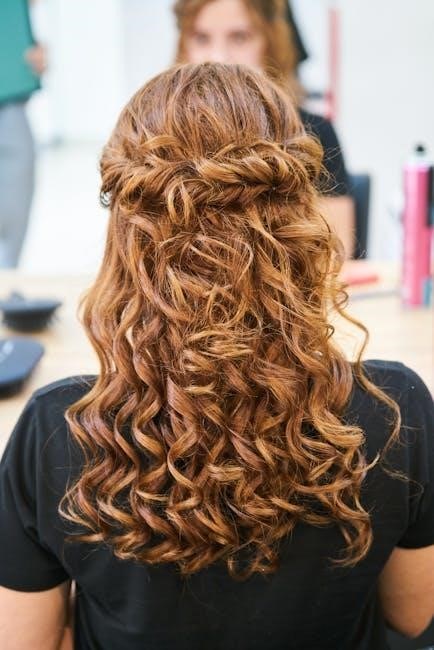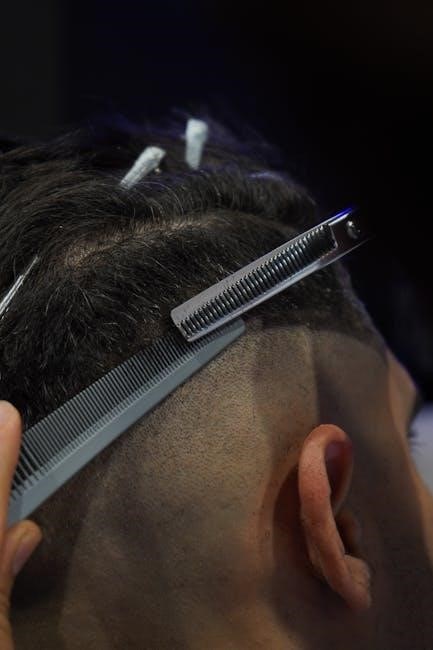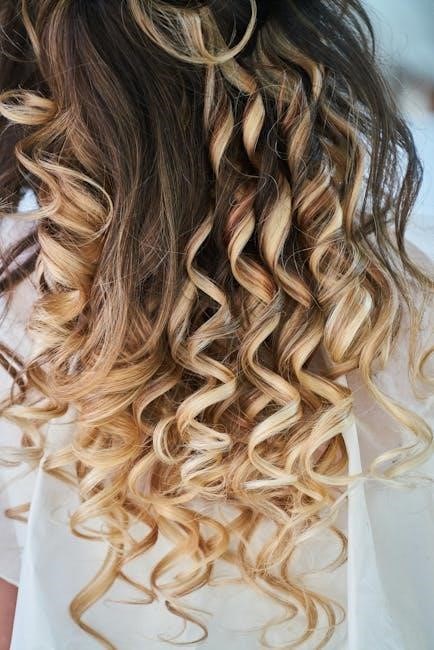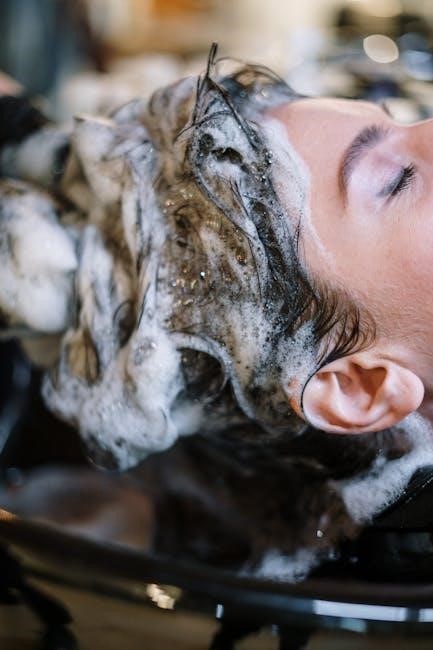
taper haircut guide
The taper haircut is a timeless style that combines modern elegance with classic appeal, offering a seamless blend of precision and versatility for various face shapes and lifestyles.
It’s a popular choice for those seeking a clean, professional look that’s easy to maintain, making it ideal for both casual and formal settings.
1.1 What is a Taper Haircut?
A taper haircut is a styling technique where hair gradually decreases in length, creating a seamless transition from the scalp to the desired length. Unlike a fade, which often features a harsher line, a taper offers a natural, subtle blend. It’s customizable to suit various hair types and face shapes, providing a clean, professional look. This style is ideal for those seeking precision and versatility, allowing for both neat and messy finishes. Its popularity stems from its ability to enhance facial features while maintaining a low-maintenance, polished appearance.
1.2 Brief History of the Taper Haircut
The taper haircut has deep roots in military and classic barbering traditions, dating back to the early 20th century. It gained prominence in the 1940s and 1950s as a symbol of neatness and professionalism. Over the decades, the style evolved, adapting to modern trends while retaining its timeless appeal. Today, it remains a staple in men’s grooming, celebrated for its versatility and enduring sophistication.
1.3 Why Choose a Taper Haircut?
The taper haircut is a versatile and low-maintenance option, suitable for various face shapes and lifestyles. It offers a clean, professional appearance while allowing for casual styling flexibility. The gradual decrease in hair length creates a sleek, modern look, making it ideal for both formal and everyday settings. Its adaptability to different hair types and styles ensures it remains a popular choice for those seeking a timeless, elegant grooming solution.
Types of Taper Haircuts
Taper haircuts come in various styles, including high, medium, low, and natural options, each offering unique looks suited to different preferences and face shapes.
2.1 High Taper Haircut
A high taper haircut features a sharp, defined cut close to the temples and back, blending seamlessly into the longer hair on top. This style creates a sleek, modern look, ideal for those seeking a bold contrast between the sides and the crown. It’s versatile, suiting most face shapes, and can be styled neatly for professional settings or messily for a casual vibe. The high taper is perfect for men who want a clean, sophisticated appearance with minimal maintenance.
2.2 Medium Taper Haircut
A medium taper haircut offers a balanced look, with a subtle gradient from the temples to the crown. It’s less dramatic than the high taper but still maintains a clean, polished finish. This style is ideal for men with oval or round face shapes, as it adds definition without being overpowering. The medium taper is versatile for both professional and casual settings, allowing for easy styling with minimal effort while keeping a sharp, modern aesthetic. It’s a great choice for those who prefer a classic yet understated look.
2.3 Low Taper Haircut
A low taper haircut features a subtle, gradual decrease in hair length from the temples down, creating a natural, understated look. This style is perfect for men with square or rectangular face shapes, as it softens sharp angles while maintaining a clean appearance. The low taper is highly versatile, suitable for both casual and professional settings, and requires minimal maintenance. It’s an excellent choice for those who prefer a sleek yet understated aesthetic that complements their natural features without being too dramatic.
2.4 Natural Taper Haircut
The natural taper haircut offers a smooth, organic transition from longer hair on top to shorter sides and back, creating a seamless blend without harsh lines. This style mimics the appearance of a natural hairline, making it ideal for those who prefer a subtle, effortless look. It’s particularly flattering for oval and round face shapes, as it adds balance and symmetry. The natural taper is low-maintenance and versatile, suitable for both casual and professional environments, making it a practical choice for everyday wear.

Understanding the Taper vs. Fade
The taper haircut features a gradual decrease in hair length, while a fade creates a more dramatic, clean transition. Both styles offer precision and modern appeal.
3.1 Differences Between Taper and Fade
A taper haircut involves a gradual reduction of hair length, typically using scissors or clippers with a guard, creating a natural, seamless transition. In contrast, a fade features a more dramatic, clean-cut transition where the hairline is cut close to the scalp, often without a guard. The taper is subtle and blends naturally, while the fade creates a sharp, defined edge. Both styles emphasize precision but cater to different aesthetic preferences, with tapers offering a softer look and fades delivering a bold, modern appearance.
3.2 When to Choose a Taper Over a Fade
Opt for a taper haircut when you desire a more subtle, natural look that blends seamlessly with your existing hairstyle. It is ideal for those with longer hair or who prefer a less dramatic transition. Tapers are also recommended for professional settings or for individuals with sensitive skin, as they require less direct scalp exposure. In contrast to fades, tapers offer a softer aesthetic, making them suitable for casual and formal occasions alike without appearing overly aggressive or trendy.

Benefits of a Taper Haircut
A taper haircut offers versatility, low maintenance, and a professional yet casual appeal, making it suitable for various lifestyles and face shapes while enhancing overall style.
4.1 Versatility for Different Face Shapes
The taper haircut is incredibly versatile, complementing a wide range of face shapes. For oval faces, it enhances symmetry, while for round faces, it creates a slimming effect. Square faces benefit from softened angles, and heart-shaped faces find balance with this style. The taper’s adaptability ensures a flattering look regardless of facial structure, making it a universally appealing choice for men seeking a tailored appearance that suits their unique features perfectly.
4.2 Low Maintenance
The taper haircut is a practical choice for those with busy lifestyles, requiring minimal upkeep. Its structured design means less frequent trims are needed, and styling is straightforward. Whether you prefer a polished look or a casual vibe, this cut maintains its shape effortlessly. Ideal for individuals who value convenience without compromising style, the taper haircut is a low-maintenance option that blends seamlessly into daily life, ensuring you look sharp with minimal effort;
4.3 Professional and Casual Options
The taper haircut offers unmatched versatility, catering to both professional and casual settings. Its sleek design makes it suitable for formal events, while its subtle transitions allow for a relaxed, everyday look. Whether you’re heading to the office or enjoying a weekend outing, this haircut adapts effortlessly. Pair it with a suit for a polished appearance or keep it natural for a laid-back vibe, making it an ideal choice for men seeking a versatile style that meets all occasions.

Choosing the Right Taper Haircut for You
Consider your face shape, lifestyle, and personal style to select a taper haircut that enhances your features and fits your daily routine. Use reference photos and clear descriptions to ensure your barber understands your vision, ensuring a tailored look that matches your preferences perfectly.
5.1 Considering Face Shape
Your face shape plays a crucial role in selecting the right taper haircut. For oval faces, a balanced taper enhances symmetry. Round faces benefit from a high taper to elongate the silhouette. Square faces look best with a medium taper to soften sharp angles. Heart-shaped faces can opt for a low taper to draw attention away from the temples. Ensuring the taper complements your natural features creates a harmonious and flattering look tailored to your unique appearance.
5.2 Lifestyle and Personal Style
Your lifestyle and personal style are key factors in choosing a taper haircut. Busy professionals may prefer a low-maintenance option, while creative individuals might opt for a bolder taper. If you enjoy styling your hair, a medium taper offers versatility with products. For a sleek look, pair your taper with a trim beard or clean shave. Consider your daily routine and personal aesthetic to ensure your taper haircut aligns with your identity and lifestyle, making it both practical and stylish.
Tools and Equipment Needed
Hair clippers, guards, trimmers, scissors, and precision accessories are essential for achieving a taper haircut, ensuring clean lines and a professional finish.
6.1 Hair Clippers and Guards
Hair clippers are the cornerstone of a taper haircut, providing precision and control. Guards of varying sizes help achieve the desired length and gradient, ensuring a seamless transition.
Shorter guards create a more defined taper, while longer guards allow for a subtler blend. High-quality clippers are essential for clean cuts and even blending, making them indispensable for both barbers and DIY enthusiasts.
Using the right guard size ensures the taper effect is consistent and professional, whether you’re aiming for a high, medium, or low taper finish.
6.2 Trimmers and Scissors
Trimmers are essential for refining edges and creating precise definitions around the ears and neckline. Cordless electric trimmers offer greater control and ease for detailed work. Scissors are ideal for finishing touches, blending layers, and achieving natural transitions. They’re particularly useful for shaping the top and sides to complement the taper. High-quality tools ensure clean cuts and prevent unevenness, making them vital for both professional barbers and at-home stylists aiming for a polished look.
6.3 Accessories for Precision
Accessories like comb attachments and adjustable guard sizes enhance precision in achieving the perfect taper. A fine-tooth comb helps section hair neatly, while a detail trimmer refines edges and tight spaces. A spray bottle keeps hair moist for easier cutting, preventing unevenness. A clean cape or towel protects clothing from clippings, ensuring a professional setup. These tools collectively aid in delivering a sharp, polished finish, essential for both barbers and home users mastering the taper haircut technique.

Step-by-Step Guide to Getting a Taper Haircut
Achieve a clean, professional look by following precise steps: prepare hair, use clippers with guards, blend layers smoothly, and finish with a razor for sharp edges.
7.1 Preparing for the Cut
Preparation is key to achieving a flawless taper haircut. Start by gathering reference photos to show your barber, ensuring they understand your desired style. Choose the right clippers and guards based on your hair length and the taper intensity you want. Wash and towel-dry your hair to ensure a clean, even cut. Clearly communicate your preferences, such as blending techniques or edge precision, to guide your barber effectively. Proper preparation ensures a smooth process and a satisfying final result.
7.2 Cutting and Blending Techniques
Mastering cutting and blending techniques is crucial for a professional taper haircut. Start by sectioning your hair to maintain control, using clips to keep longer sections out of the way. Use clippers with the appropriate guard size, working gradually from the lowest point upward. Feather the clippers at the transition point for a seamless blend, ensuring no harsh lines remain. For the neckline, use a trimmer without a guard for a sharp edge, then blend it with light strokes to avoid noticeable demarcation. This method creates a smooth, natural-looking fade that enhances the taper effect.
Common Mistakes to Avoid
Common mistakes include using the wrong guard size, uneven blending, and cutting too aggressively, which can lead to an unbalanced or unnatural-looking taper haircut.
8.1 Incorrect Guard Size
Using the wrong guard size is a common mistake that can ruin the taper haircut. A guard too small may result in uneven layers, while a guard too large can leave excess hair, disrupting the seamless transition. This mismatch often leads to a lack of definition and a less polished finish. To avoid this, ensure the guard size aligns with your desired taper length and consult a professional for precise measurements, especially if you’re new to taper cuts. Reference photos can also help guide the process for better accuracy.
8.2 Uneven Blending
Uneven blending is a frequent error that disrupts the smooth transition of a taper haircut. It often occurs when the clippers are not angled correctly or when the barber fails to maintain consistent pressure. This can leave noticeable lines or patches, ruining the desired seamless look. To prevent this, use reference photos to guide the process and ensure proper technique. Checking your work as you go and using high-quality tools can also help achieve a more balanced and professional finish.

Styling Your Taper Haircut
A taper haircut offers versatility, allowing you to style it neatly for professional settings or messily for a casual look using products like pomade or matte paste.
9.1 Recommended Products
For styling a taper haircut, consider using lightweight products like matte paste or pomade for a sleek look. Styling creams add texture without stiffness, while gels provide hold for spiky styles. Use sea salt spray for a natural, tousled finish or a comb for a polished appearance. Lightweight products are ideal for maintaining the haircut’s definition without weighing it down, ensuring a fresh and modern look for any occasion.
9.2 Pairing with Other Hairstyles
A taper haircut pairs seamlessly with various styles, such as an undercut for contrast or a side part for sophistication. It complements beards or stubble for a rugged look and works well with fringe for added texture. Pairing it with a quiff or pompadour adds height and volume, creating a modern aesthetic. This versatility allows the taper cut to adapt to diverse face shapes and personal styles, making it a timeless choice for both casual and formal settings.
How to Explain Your Desired Taper Haircut to a Barber
Bring reference photos and describe the taper height, blending, and style details. Use terms like “high,” “low,” or “natural” taper to ensure clarity and precision.
10.1 Using Reference Photos
Reference photos are essential for ensuring your barber understands your vision. Collect images of taper haircuts that match your desired style, paying attention to the taper height, blending, and overall look. Show these to your barber to avoid miscommunication and guarantee a precise result. Photos from reliable sources like hairstyle websites or social media can serve as clear guides. This visual aid helps both you and your barber align on the exact style you want to achieve.
Be specific about the details in the photos, such as the fade gradient, hair length, and parting style. This ensures your barber can replicate the look accurately, tailored to your preferences and face shape.
10.2 Describing the Style Clearly
Clearly explaining your desired taper haircut is crucial for achieving the perfect look. Use descriptive terms like “high taper,” “natural blend,” or “messy texture” to convey your vision. Mention specifics such as the height of the taper, how much blending you prefer, and whether you want a clean or textured finish. This ensures your barber understands your style goals and can tailor the cut to suit your face shape and personal preferences.
Be precise about details like hair length on top, parting style, and any additional features you want, such as a fade or fringe. Clear communication guarantees a customized result that meets your expectations.
Taper Haircut Trends
Taper haircuts remain a popular choice, with modern variations like subtle tapers and textured finishes gaining traction. Celebrity influences and evolving grooming trends continue to shape its appeal.
11.1 Modern Variations
Modern taper haircuts emphasize subtle gradients and textured finishes, blending seamlessly into current grooming trends. Many opt for a refined, natural look with slight fades, while others embrace bold contrasts. Texture is key, with stylists incorporating layering techniques to add volume and depth. Celebrities often showcase these styles, inspiring fans to experiment. The evolution of taper haircuts highlights adaptability, catering to diverse preferences while maintaining a sleek, polished appearance. This versatility ensures the taper remains a timeless yet contemporary choice for men.
11.2 Celebrity Influences
Celebrities play a significant role in popularizing taper haircuts, with stars like David Beckham and Brad Pitt often showcasing sleek, tailored styles. Their influence highlights the versatility of the taper, making it a go-to choice for red-carpet events and everyday looks. Fans draw inspiration from these icons, adapting the style to suit their own face shapes and lifestyles. Celebrity endorsements have cemented the taper haircut’s status as a timeless, adaptable, and fashionable choice, encouraging men to embrace its clean, polished appeal.